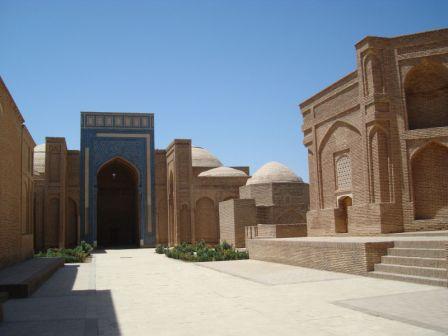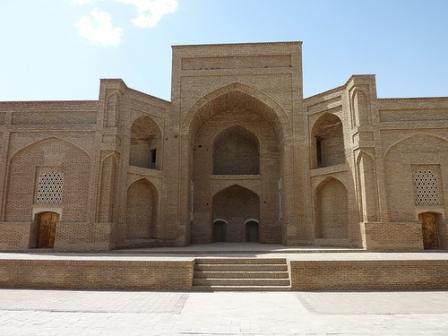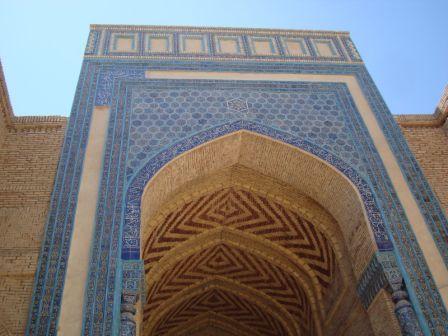|
Category
|
Sultan Saodat Mausoleum
In Termez survived two major religious-memorial complex, formed at the graves of the saints, and a very respected at this time. It is a complex with the mausoleum of Hakim al-Termizi - a prominent theologian IX c. and the Sultan Saodat complex at tombs of powerful dynasty Termez Sayids, which was formed during the XI-XVII centuries. Termez Sayyids, according to legend, are direct descendants of the Prophet Muhammad. The founder of the kind of Termez was Sayid Hassan al-Amir, the fifth generation of Imam Hussein, grandson of Muhammad.
Subsequently, many buildings of the complex in different versions of this ancient idea of repeating groups of buildings, ie detailed three-part frontal facade with an open “aiwan” in the center. A very interesting by architecture and unusual by plan is building of Kokildor-ota mausoleum (XVI c.). This portal-dome multi-track construction of the front with brick wall texture. It repeated the same as in other buildings of the complex of Sultan Saodat, the idea of a three-part expanded frontal facade. Deep portal led into a large domed hall, which is located on the sides of two rooms and a corridor. Most notable in the cast of the interior decorative arches “ganch”.
In the second half of XV century ahead of the two mausoleums built two new ones. The structures superimposed in the XV-XVII centuries two parallel rows. Here are some new mausoleums were also mutually connected intermediate aiwan, decoration on them anymore. In the XVI-XVII centuries the south and the north side of courtyard was built up the mausoleums of different sizes and different ages. On the west side of the yard was set up entry. The magnificent ensemble stands out for its group of mausoleums, homogeneous in structure and decoration, though built in different styles. In the XIX century buildings in the complex is gradually destroyed and come to desolation. At present, on territory of the complex of Sultan Saodat held resurfacing and restoration work. |
 In contrast to other regions of Uzbekistan the Surkhandarya architecture school is characterized by modestly decorated mausoleums with brick wall texture. Many of them were built over the burial of revered Muslim saints. Their burial tradition became a place of worship and pilgrimage.
In contrast to other regions of Uzbekistan the Surkhandarya architecture school is characterized by modestly decorated mausoleums with brick wall texture. Many of them were built over the burial of revered Muslim saints. Their burial tradition became a place of worship and pilgrimage. The Sultan Saodat complex is a series of multi religious buildings - mausoleums, mosques, khanaka - erected around the perimeter of the yard, and formed the elongated coherent and concise composition. The oldest here are two large single-chamber, in terms of square domed mausoleum X-XI centuries, located in the southwestern part of the complex. They are united by a deep located between the vaulted "aiwan" (gallery), which at the turn of the XIV - XV centuries, was added to the height and faced with multicolored glazed decoration.
The Sultan Saodat complex is a series of multi religious buildings - mausoleums, mosques, khanaka - erected around the perimeter of the yard, and formed the elongated coherent and concise composition. The oldest here are two large single-chamber, in terms of square domed mausoleum X-XI centuries, located in the southwestern part of the complex. They are united by a deep located between the vaulted "aiwan" (gallery), which at the turn of the XIV - XV centuries, was added to the height and faced with multicolored glazed decoration. Thanks to the clear structure, decor and size, the composition of the mausoleums is a great architectural design. The unity of the structure pointed burnt bricks, which served both constructive and decorative material (masonry "in the fir-tree", the curly ribbon carved blocks, geometric and floral motifs of the paste and the straps figured hewn blocks). Both shrines crowded gravestones, some remnants of tiled decoration.
Thanks to the clear structure, decor and size, the composition of the mausoleums is a great architectural design. The unity of the structure pointed burnt bricks, which served both constructive and decorative material (masonry "in the fir-tree", the curly ribbon carved blocks, geometric and floral motifs of the paste and the straps figured hewn blocks). Both shrines crowded gravestones, some remnants of tiled decoration.














